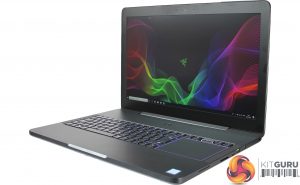Razer’s latest machine is aiming to appeal to both workers and gamers, and the dual approach starts with the Blade Pro’s physical design.
This machine has a sleek body that’s equally at home at a LAN party or an office. The Blade Pro is made from machined aluminium that’s got a smart, understated matte black finish. There’s not much ornamentation – you get the familiar green Razer logo and some subtle Blade text on the screen bezel, but that’s it.
The Blade Pro has solid dimensions to pair with its good looks. It weighs 3.07kg, which is reasonable for a 17.3in machine, and it’s only 23mm thick – an excellent figure. That makes it a couple hundred grams heavier than the Asus ROG Strix Scar, the Razer’s main rival, though it is is a couple of millimetres slimmer.
So, when it comes to high-end 17.3in gaming laptops, the Razer Blade Pro has decent dimensions alongside a smart and subtle design. It competes with the Scar, and it’s also slimmer and lighter than other machines like the PC Specialist Defiance IV or Asus ROG GL702ZC.
The Blade Pro’s high-quality feel continues once we get to using the machine. The lid opens up smoothly on its well-balanced hinge, and build quality is excellent: there’s no give in any of this machine’s metal surfaces, and the screen is sturdy.
We’d still use a sleeve or a case to avoid any scuffs or scratches on the pristine metal, but the Blade Pro remains one of the strongest machines on the market.
Open up the lid and you’ll see the Blade Pro’s big change. Instead of positioning the trackpad below the keyboard, Razer has slotted the pad on the right-hand side of the keyboard in order to mimic the way people work and play games when they’re sat at a desk.
The keyboard still takes up most of the base, of course, and there’s no room for a numpad. The trackpad is large, and surrounded by a ring of subtle RGB illumination, and at the top there’s a grippy scroll-wheel and four media buttons.
In terms of I/O, Razer’s machine serves up three USB 3.0 connectors, a card reader, one audio jack and an HDMI output. It’s also got one Thunderbolt 3 (Type-C) port. That’s OK, but the PC Specialist machine had a fourth USB port, two mini-DisplayPort outputs and three audio jacks in addition to what we’ve already mentioned here.
The Razer also loses out when it comes to internal access. It’s virtually impossible to open this machine up and there isn’t any expansion room. The PC Specialist, conversely, offered access to all of its internals for upgrades and cleaning.
That’s to be expected from a machine that’s slim, light and stylish, however. Razer’s system has the aesthetic design and the build quality to beat virtually everything else in the market right now, even if you’ll have to pay more for the privilege.
 KitGuru KitGuru.net – Tech News | Hardware News | Hardware Reviews | IOS | Mobile | Gaming | Graphics Cards
KitGuru KitGuru.net – Tech News | Hardware News | Hardware Reviews | IOS | Mobile | Gaming | Graphics Cards






